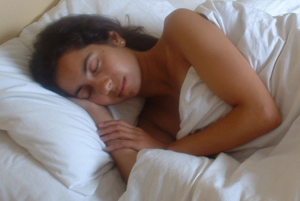|
Researchers are
investigating how playing sounds to a sleeping person can affect
their dreams.
by Katherine Nightingale
 Courtesy of Luke Jerram
Courtesy of Luke Jerram
Sound asleep? Researchers are looking at how sounds from the external environment can affect dreams.
|
|
When we sleep, our eyes are closed, but our ears still seem to be open. Sounds in our environment can incorporate themselves into our dreams and psychologists at the University of the West of England in Bristol, U.K. are studying how this can affect sleep. Collaborating with them is an artist, Luke Jerram, who has recently created the Sky Orchestra. Composed of seven hot air balloons each playing a different part of a musical score, he is releasing the balloons at dawn over different cities to see if they influence the sleep of local residents.
The early morning is prime time for affecting people's dreams. Throughout the night, sleep cycles through five stages: four non-REM (Rapid Eye Movement) stages and one REM stage. Most dreams occur during REM sleep when activity in the brain's neurons is heightened and similar to being awake. Since periods of REM sleep get longer throughout the night - typically lasting about ten minutes early on and increasing to about one hour - people tend to have more dreams before they wake up.
But the problem for dream researchers is that people don't always remember their dreams. As beautiful and inspiring as the Sky Orchestra is, it is hard to tell what its results are. Although people who have experienced it can fill in a questionnaire explaining how their dreams were affected, the researchers often find that most people remember being woken up and rushing to the window to see what was happening!
 Courtesy of Luke Jerram
Courtesy of Luke Jerram
The Sky Orchestra: Artist Luke Jerram has been releasing hot air ballons that play music at dawn to see how it affects the sleepers below.
|
So Jerram is finding another way of informing his Sky Orchestra work. The team is working on the Dream Director, a device that monitors the heart rate of a sleeper and then plays music embedded with specific sounds - for example the sound of a cash register - when it detects REM sleep. People are asked to report their dreams so that the researchers can investigate whether or not the sounds have had an effect.
The Dream Director is presently being tested and if the team finds that the sounds are being incorporated into dreams, it could be used as a therapeutic aid for people who experience traumatic dreams. But Jennie Parker, a psychologist and one of the researchers, still thinks there is a lot of work to be done to determine the potential of the device. Since it uses many typical sounds, it could be difficult for the researchers to determine if dream imagery was actually caused by the Dream Director. "We should really be waiting to see what we find from these initial pilot studies before we start making any predictions about what the Dream Director can actually do," she says. "This is very new work, it is absolutely in its infancy."
 Courtesy of Luke Jerram
Courtesy of Luke Jerram
The Dream
Director records the person's heart rate and the stage of
sleep they are in.
|
Sleep research in itself is quite a
new discipline and was only established in the 1950s after REM sleep
was discovered and related to dreaming. The purpose of dreams and
the legitimacy of dream therapy is still being debated. According
to Professor Jim Horne, Director of Loughborough Sleep Centre, since
dreams occur during periods of very light sleep, external stimuli
can become incorporated into them, but whether this is significant
is another matter. Although he thinks that dreams play a role in
keeping our brain stimulated while we sleep, he is also sure that
we could do without them. "Some antidepressants remove REM sleep
with no apparent detriment to the patient," he says. "If people
have traumatic dreams and are disturbed by them then it's probably
better to remove them."
But Parker does believe that dreams are important and allow the brain to process emotional information. "I don't necessarily think the images are important but the emotional content is. We need to remember that they are universal and are the most recurring form of altered consciousness," she says.
Since the project straddles the disciplines of science and art, it is not only fuelling the advancement of sleep research but also allowing Jerram to create artwork. His goals are very different from those of the psychologists since for him, the scientific results are a means of producing his art. If the Dream Director is able to successfully alter dreams, he will create a multimedia installation that gallery-goers can borrow overnight to try and go beyond their wildest dreams.
For more information:
Luke Jerram's web site
http://lukejerram.com
Loughborough Sleep Research Centre
http://www.lboro.ac.uk/departments/hu/groups/sleep/
|
